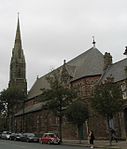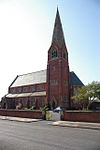Craven Park, Barrow-in-Furness
American football venues in the United KingdomBarrow-in-FurnessDefunct greyhound racing venues in the United KingdomEnglish sports venue stubsEngvarB from May 2014 ... and 4 more
Rugby League World Cup stadiumsRugby league stadiums in EnglandSports venues completed in 1931Sports venues in Barrow-in-Furness

Craven Park is a rugby league stadium in Barrow-in-Furness, Cumbria, England. It is the home of Barrow Raiders rugby league team.
Excerpt from the Wikipedia article Craven Park, Barrow-in-Furness (License: CC BY-SA 3.0, Authors, Images).Craven Park, Barrow-in-Furness
Hindpool Road,
Geographical coordinates (GPS) Address External links Nearby Places Show on map
Geographical coordinates (GPS)
| Latitude | Longitude |
|---|---|
| N 54.115 ° | E -3.2352777777778 ° |
Address
Craven Park
Hindpool Road
LA14 1YB , Hindpool
England, United Kingdom
Open on Google Maps










